1997 PONTIAC BONNEVILLE belt
[x] Cancel search: beltPage 170 of 405
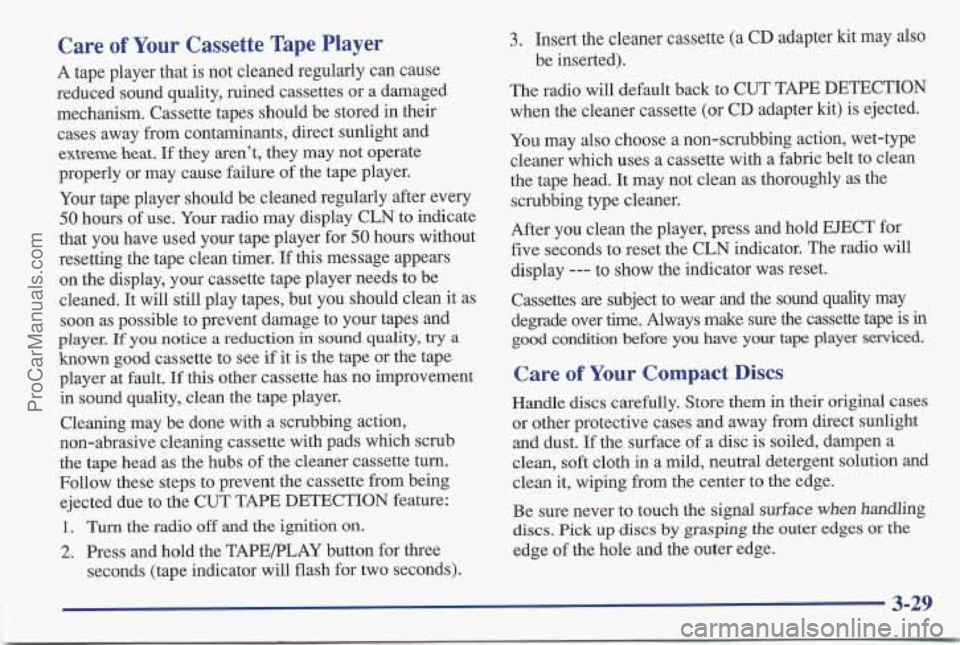
Care of Your Cassette Tape Player
A tape player that is not cleaned regularly can cause
reduced sound quality, ruined cassettes or a damaged
mechanism. Cassette tapes should be stored in their
cases away from contaminants, direct sunlight and
extreme heat. If they aren’t, they may not operate
properly or may cause failure of the tape player.
Your tape player should be cleaned regularly after every
50 hours of use. Your radio may display CLN to indicate
that you have used your tape player for
50 hours without
resetting the tape clean timer. If this message appears
on the display, your cassette tape player needs to be
cleaned. It will still play tapes, but you should clean it as
soon as possible to prevent damage to your tapes and
player. If you notice a reduction in sound quality, try a
known good cassette to see if it is the tape or the tape
player at fault.
If this other cassette has no improvement
in sound quality, clean the tape player.
Cleaning may be done with
a scrubbing action,
non-abrasive cleaning cassette with pads which scrub
the tape head
as the hubs of the cleaner cassette turn.
Follow these steps to prevent the cassette from being ejected due to the CUT TAPE DETECTION feature:
1. Turn the radio off and the ignition on.
2. Press and hold the TAPEPLAY button for three
seconds (tape indicator will flash for two seconds).
3. Insert the cleaner cassette (a CD adapter kit may also
be inserted).
The radio will default back to CUT TAPE DETECTION
when the cleaner cassette (or CD adapter kit) is ejected.
You may also choose a non-scrubbing action, wet-type
cleaner which uses a cassette with a fabric belt to dean
the tape head.
It may not clean as thoroughly as the
scrubbing type cleaner.
After you clean the player, press and hold
EJECT for
five seconds to reset the CLN indicator. The radio will
display
--- to show the indicator was reset.
Cassettes are subject to wear and the sound quality may
degrade over time. Always make sure the cassette tape is
in
good condition before you have your tape player serviced.
Care of Your Compact Discs
Handle discs carefully. Store them in their original cases
or other protective cases and away from direct sunlight
and dust.
If the surface of a disc is soiled, dampen a
clean, soft cloth in a mild, neutral detergent solution and
clean it, wiping from the center to the edge.
Be sure never to touch the signal
surface when handling
discs. Pick up discs by grasping the outer edges or the
edge of the hole and the outer edge.
ProCarManuals.com
Page 175 of 405
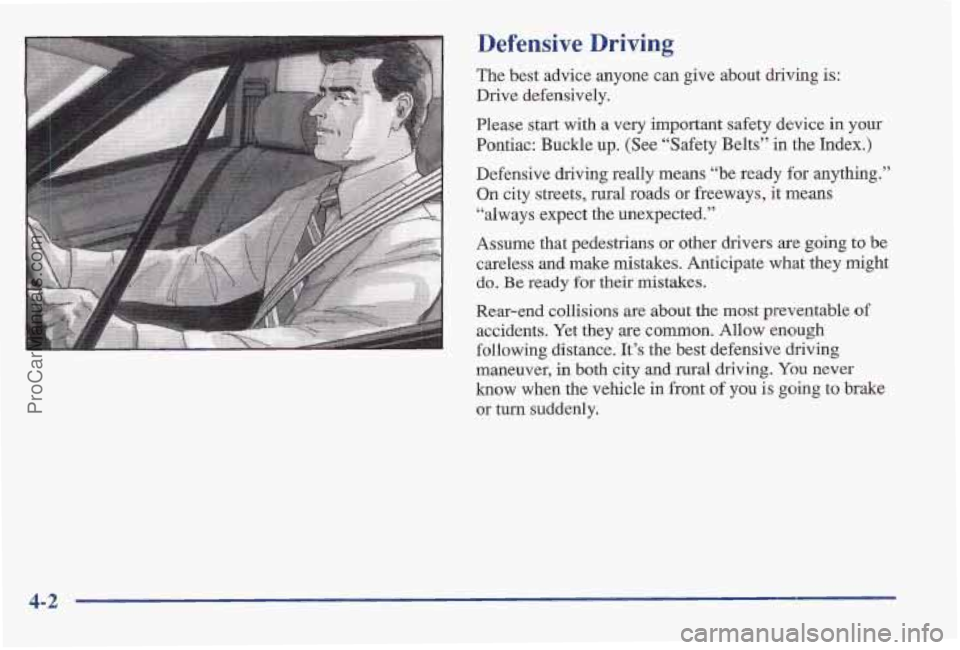
Defensive Driving
The best advic’e anyone can give about driving is:
Drive defensively.
Please start with a very important safety device
in your
Pontiac: Buckle up. (See “Safety Belts” in the Index.)
Defensive driving really means “be ready for anything.”
On city streets, rural roads or freeways, it means
“always expect the unexpected.”
Assume that pedestrians
or other drivers are going to be
careless and
make mistakes. Anticipate what they might
do. Be ready for their mistakes.
Rear-end collisions
are about the most preventable of
accidents. Yet they are common. Allow enough
following distance. It’s the best defensive driving
maneuver,
in both city and rural driving. You never
know when the vehicle
in front of you is going to brake
or turn suddenly.
4-2
ProCarManuals.com
Page 185 of 405
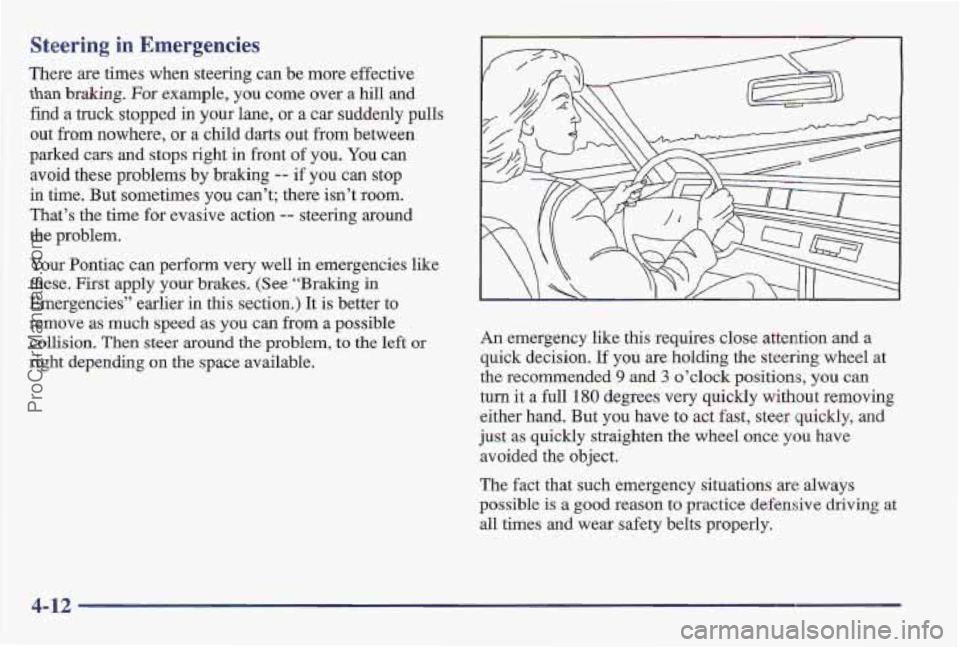
Steering in Emergencies
There are times when steering can be more effective
than braking. For example, you come over a hill and
find
a truck stopped in your lane, or a car suddenly pulls
out from nowhere, or a child darts out from b’etween
parked cars
and stops right in front of you. You can
avoid these problems
by braking -- if you can stop
in time. But sometimes
you can’t; there isn’t room.
That’s the time for evasive action -- steering around
the problem.
Your Pontiac can perform very well in emergencies like
these. First apply your brakes. (See “Braking
in
Emergencies” earlier in this section.) It is better to
remove
as much speed as you can from a possible
collision. Then steer around the
problem, to the left or
right depending on the space available.
An emergency like this requires close attention and a
quick decision.
If you are holding the steering wheel at
the recommended 9 and 3 o’clock positions, you can
turn it a full 180 degrees very quickly without removing
either hand. But
you have to act fast, steer quickly, and
just as quickly straighten the wheel once you have
avoided the object.
The fact that such emergency situations are always
possible is a
good reason to practice defensive driving at
all times and wear safety belts properly.
4-12
ProCarManuals.com
Page 211 of 405
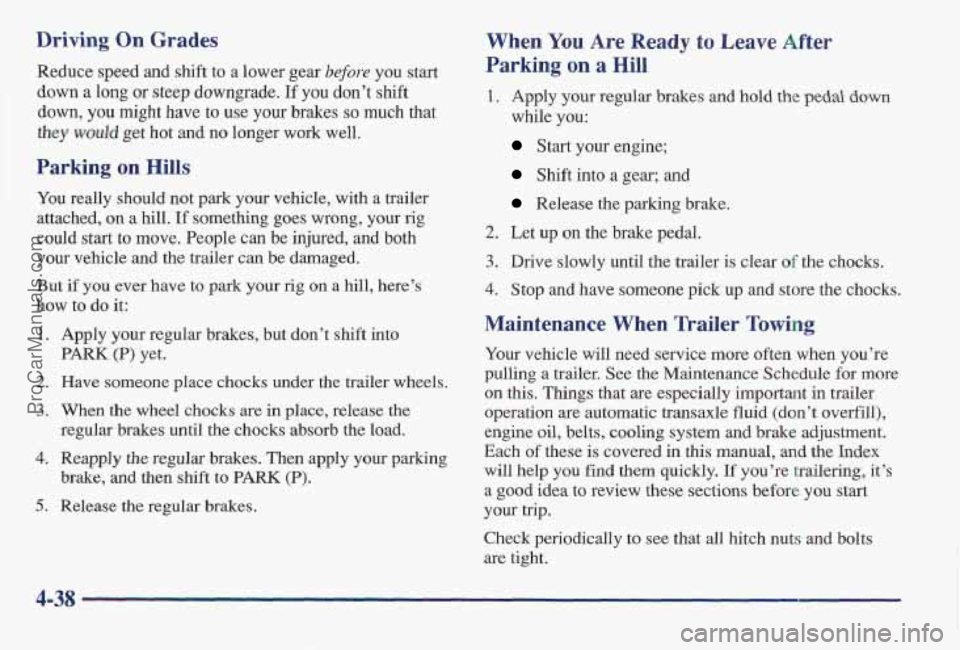
Driving On Grades
Reduce speed and shift to a lower gear before you start
down
a long or steep downgrade. If you don’t shift
down,
you might have to use your brakes so much that
they would get hot and no longer work well,
Parking on Hills
You really should not park your vehicle, with a trailer
attached,
on a hill. If something goes wrong, your rig
could start
to move. People can be injured, and both
your vehicle and the trailer can be damaged.
But
if you ever have to park your rig on a hill, here’s
how to
do it:
1.
2.
3.
4.
5.
Apply your regular brakes, but don’t shift into
PARK (P) yet.
Have someone place chocks under the trailer wheels.
When the wheel chocks are in place, release the
regular brakes until the chocks absorb the load.
Reapply the regular brakes. Then apply your parking
brake, and then shift
to PARK (P).
Release the regular brakes.
When You Are Ready to Leave After
Parking
on a Hill
1. Apply your regular brakes and hold the pedal down
while you:
Start your engine;
Shift into a gear; and
Release the parking brake.
2. Let up on the brake pedal.
3. Drive slowly until the trailer is clear of the chocks.
4. Stop and have someone pick up and store the chocks.
Maintenance When Trailer Towing
Your vehicle will need service more often when you’re
pulling a trailer. See the Maintenance Schedule for more
on this. Things that are especially important in trailer
operation are automatic transaxle fluid (don’t overfill),
engine oil, belts, cooling system and brake adjustment.
Each of these is covered in this manual, and the Index
will help you find them quickly. If you’re trailering, it’s
a good idea to review these sections before you start
your trip.
Check periodically to see that all hitch nuts and bolts
are tight.
4-38
ProCarManuals.com
Page 254 of 405
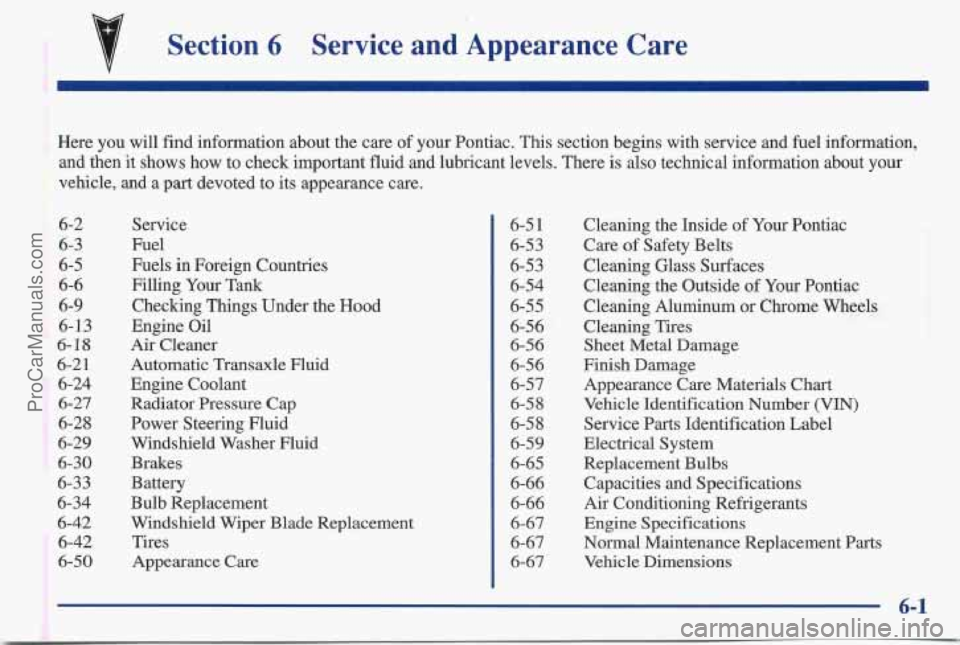
v Section 6 Service and Appearance Care
Here you will find information about the care of your Pontiac. This section begins with service and fuel information,
and then it shows how to check important fluid and lubricant levels. There is also technical information about your
vehicle, and a
part devoted to its appearance care.
6-2
6-3
6-5
6-6
6-9
6-13
6-18
6-2 1
6-24
6-27
6-28
6-29
6-30
6-33
6-34
6-42
6-42
6-50 Service
Fuel
Fuels in Foreign Countries
Filling Your Tank
Checking Things Under the Hood
Engine Oil
Air Cleaner
Automatic Transaxle Fluid
Engine Coolant
Radiator Pressure Cap
Power Steering Fluid
Windshield Washer Fluid
Brakes
Battery
Bulb Replacement
Windshield Wiper Blade Replacement
Tires
Appearance
Care
6-5 1
6-53
6-53
6-54
6-55
6-56
6-56
6-56
6-57 6-58
6-58
6-59
6-65
6-66
6-66
6-67
6-67
6-67 Cleaning the Inside
of
Your Pontiac
Care
of Safety Belts
Cleaning Glass Surfaces Cleaning the Outside of Your Pontiac
Cleaning Aluminum
or Chrome Wheels
Cleaning Tires Sheet Metal Damage
Finish Damage
Appearance Care Materials Chart
Vehicle Identification Number (VIN)
Service Parts Identification Label
Electrical System
Replacement Bulbs
Capacities and Specifications
Air Conditioning Refrigerants
Engine Specifications
Normal Maintenance Replacement Parts
Vehicle Dimensions
ProCarManuals.com
Page 266 of 405

Supercharged Engine (Option)
Your Bonneville may have a 3800 Supercharged engine.
The supercharger is a device which is designed to pump
more air into the engine than
it would normally use.
This air mixed with fuel, creates increased engine
power. Since the supercharger is a pump and is driven
from an engine accessory drive belt, increased pressure
is available in all driving conditions.
The Powertrain Control Module (PCM) works with
a vacuum control to regulate the increased pressure
required during specific driving conditions. When this
increased pressure or boost
is not desired, such as during
idling and light throttle cruising, the excess air that the
supercharger is pumping is routed through a bypass.
AI1 of these controls working together provide high
performance character and fuel efficiency in the
3800 V6 Supercharged engine.
Engine Oil
CHECK OIL
LEVEL
If the CHECK OIL LEVEL
light on the instrument panel
comes on, it means you need
to check your engine
oil
level right away. For more
information, see “Check
Oil
Level Light’’ in the Index.
You should check your
engine
oil level regularly;
this is
an added rerninder.
It’s a good idea to check your engine oil every time you
get
fuel. In order to get an accurate reading, the oil must
be warm and the vehicle must be on level ground.
6-13
ProCarManuals.com
Page 299 of 405
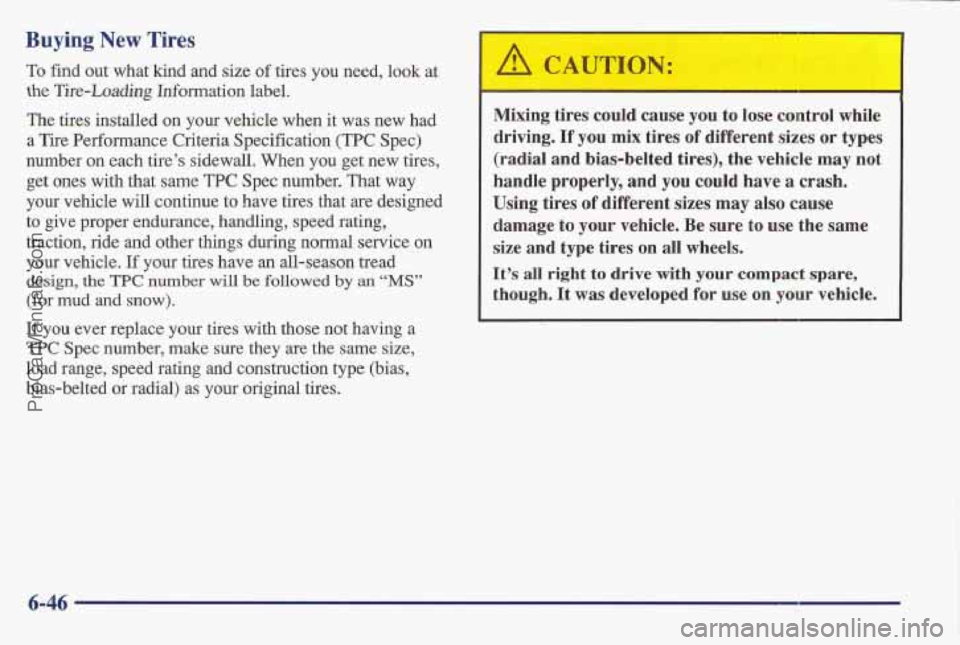
Buying New Tires
To find out what kind and size of tires you need, look at
the
Tire-Loading Information label.
The tires installed on your vehicle when it was new had
a Tire Performance Criteria Specification (TPC Spec)
numb’er on each tire’s sidewall. When you get new tires,
get ones with that
same TPC Spec number. That way
your vehicle will continue
to have tires that are designed
to give proper endurance, handling, speed rating,
traction, ride and other things during normal service
on
your vehicle. If your tires have an all-season tread
design, the TPC number will be followed by an “MS”
(for mud and snow).
If you ever replace your tires with those not having a
TPC Spec number, make sure they are the same size,
load range, speed rating and construction type (bias,
bias-belted or radial) as your original tires. Mixing tires
could cause
you to lose control w: e
driving. If you mix tires of different sizes or types
(radial and bias-belted tires), the vehicle may not
handle properly, and you could have a crash.
Using tires of different sizes may also cause
damage
to your vehicle. Be sure to use the same
size and type tires on all wheels.
It’s all right to drive with your compact spare,
though. It was developed for use on your vehicle.
6-46
ProCarManuals.com
Page 306 of 405
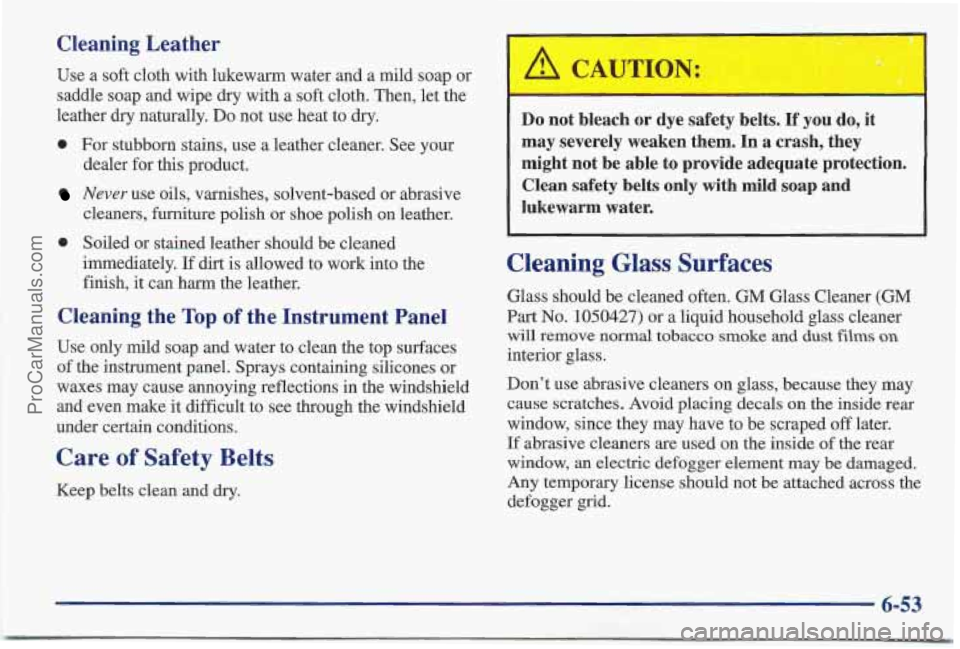
Cleaning Leather
Use a soft cloth with lukewarm water and a mild soap or
saddle soap and wipe dry with a soft cloth. Then, let the
leather dry naturally.
Do not use heat to dry.
0 For stubborn stains, use a leather cleaner. See your
dealer for this product.
cleaners, furniture polish or shoe polish on leather.
Soiled or stained leather should be cleaned
immediately.
If dirt is allowed to work into the
finish, it can harm the leather.
Never use oils, varnishes, solvent-based or abrasive
Cleaning the Top of the Instrument Panel
Use only mild soap and water to clean the top surfaces
of the instrument panel. Sprays containing silicones or
waxes may cause annoying reflections in the windshield
and even make
it difficult to see through the windshield
under certain conditions.
Care of Safety Belts
Keep belts clean and dry.
I ,A CAUTION:
Do not bleach or dye safety belts. If you do, it
may severely weaken them. In a crash, they
might not be able to provide adequate protection.
Clean safety belts only with mild
soap and
lukewarm water.
Cleaning Glass Surfaces
Glass should be cleaned often. GM Glass Cleaner (GM
Part No. 1050427) or a liquid household glass cleaner
will remove normal tobacco smoke and dust films on
interior glass.
Don’t use abrasive cleaners on glass, because they may
cause scratches. Avoid placing decals
on the inside rear
window, since they may have to be scraped off later.
If abrasive cleaners are used on the inside of the rear
window,
an electric defogger element may be damaged.
Any temporary license should not be attached across the
defogger grid.
~~ 6-53
ProCarManuals.com